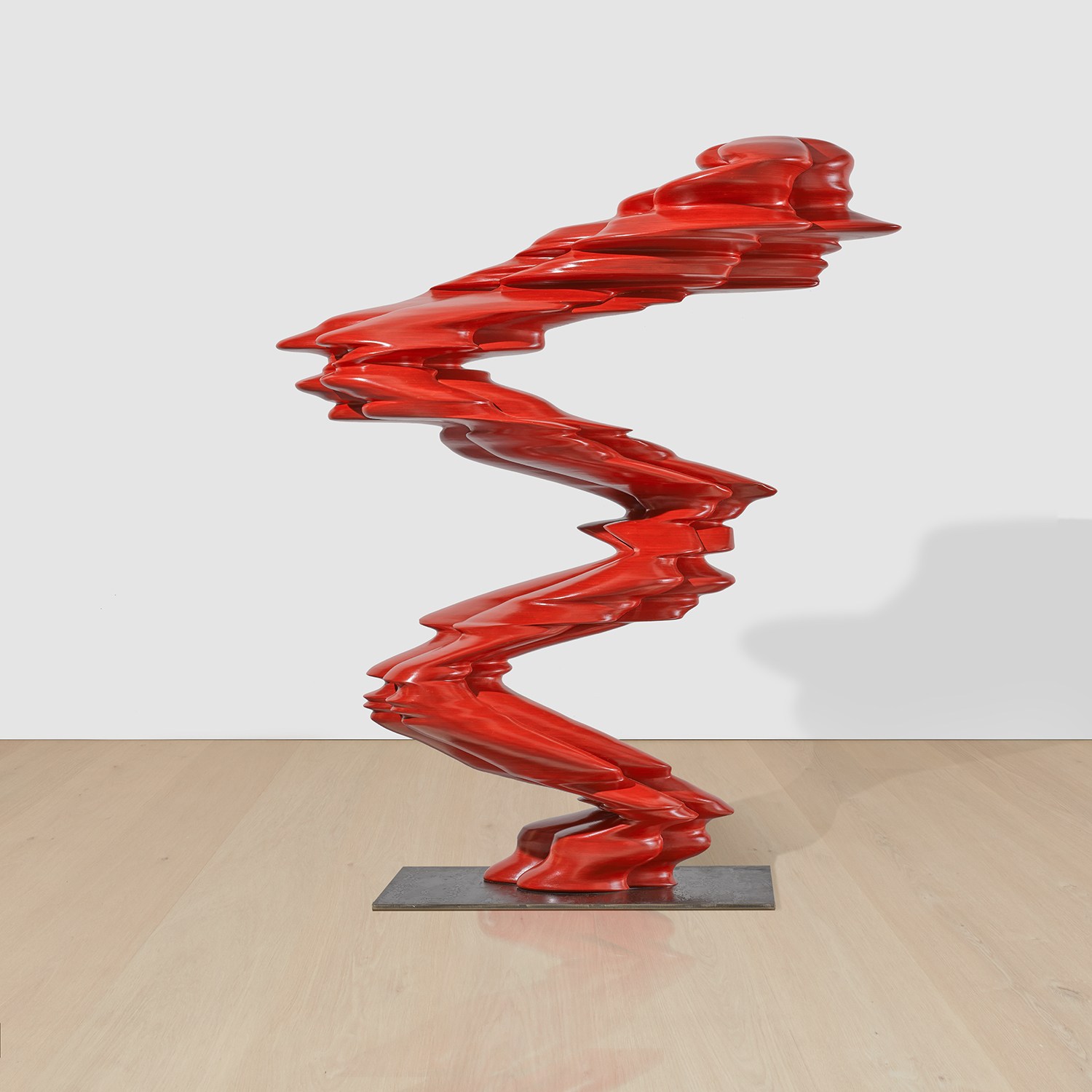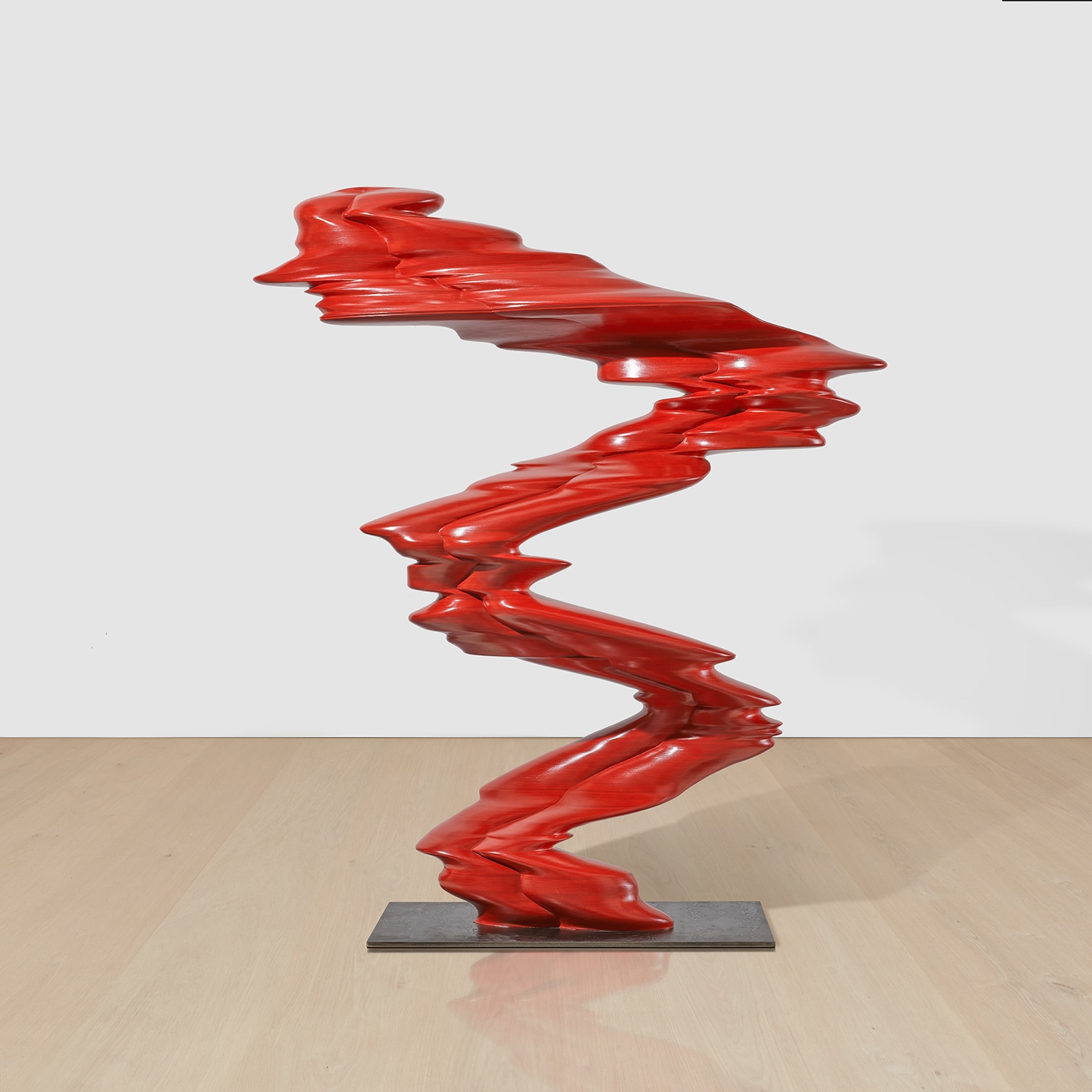

344
Tony Cragg
Red Figure
- Estimate
- $200,000 - 300,000
Further Details
Executed in 2014, Red Figure is a distinct example of Tony Cragg’s iconic Rational Being series that catapulted him to critical acclaim in the 1990s. Soaring over seven feet high, the monumental red lacquered wood sculpture is a totem to Cragg’s unique visual language that has pushed the medium of sculpture to a new realm of expression. Moving beyond representation, Cragg crucially synthesizes the figurative and the abstract, infusing his seemingly inert materials with an undeniable sense of movement. With its soaring, biomorphic zig zag form, Red Figure is captured as if in a state of metamorphosis— striding forward in a manner reminiscent to Italian Futurist Umberto Boccioni’s famous sculpture Unique Forms of Continuity in Space, 1913/50, while equally eluding concrete grasp. A testament to Cragg’s visionary sculptural idiom, another wood example from the Red Figure series was notably shown alongside the 17th and 18th century sculpture masterpieces at the Cour Marly and Cour Puget at the Louvre Museum in 2011.
“[Cragg’s works] remind us that all is ultimately moving, seething and active in the world and that nothing is really static.”
—Jon Wood
Red Figure reflects Cragg’s interest in the relationship between the natural and the manmade worlds, a theme that he pursued early on in his sculpture but has increasingly formalized in recent work. Appearing as if growing and swerving within and around itself, Red Figure is at once otherworldly and distinctly organic. It evokes a moment of transformation frozen amidst its flux. “The creation of objects and images that don’t exist in the natural or functional world but that are able to reflect and transmit information and sensations about the world and its very existence,” as Cragg states, is a crucial guiding philosophy of his practice.i Red Figure equally evokes plush drifts of snow, milky-smooth stalagmites and jagged walls of shale stone. Geology and paleontology have been particular influences for Cragg, who recalls reading sculptural forms within the fossils collected during his youth in the South of England.
“We have gone beyond the stage where we can just represent things in sculpture. We have to find new means of expression, a new visual language. ”
—Tony Cragg
Cragg came to prominence as a key member of the New British Sculpture movement in the 1980s, where, alongside artists like Antony Gormley, Anish Kapoor and Richard Deacon, his work was seen as a counterreaction to the previous generation’s embrace of minimalism and conceptualism. While abstract, his sculpture represented a departure from the prevailing aesthetic with its inspiration in organic structures. Cragg’s interest in the geometries of organic forms like bone structures, cells and molecules recalls the biomorphism of fellow Brits Henry Moore and Barbara Hepworth. The undeniable sense of movement in his sculpture also bespeaks the influence of artists such as Umberto Boccioni and Constantin Brancusi.
“I believe in thinking with material. ”
—Tony Cragg
Now based in Wuppertal, Germany, Cragg builds his works by stacking layers upon layers of circular and elliptical plywood discs, composing them into surprising curves. The rugged edges of the individual discs are then sanded down until a smooth, biomorphic form emerges. Transcendent metamorphosis of an unassuming material is part of the artist’s objective. As he explains: “The reason I am so interested in plywood is that it’s a man-made material. Man-made materials are always inferior, so I try to give them another value, another quality.”ii Describing himself as a ‘radical materialist,’ Cragg relishes in the physical properties of the materials he works with and constantly expands the mediums in his working repertoire. The artist even considers how molecular-level properties influence the final sculptural form. Elaborating on his reverence to the materials he works with, Cragg rhetorically questions: “The word material originates from the Latin word mater, mother, so why wouldn’t material be something that we love and respect and hold in high regard[?]”iii
Tony Cragg: In the Studio
iTony Cragg in Roderick Conway Morris, “Inventing a ‘New Visual Language,’” The New York Times, October 13, 2010, online
iiTony Cragg in Alexia Antsakli Vardinoyanni, “Tony Cragg: Master of Materials,” Art Flyer, online
iiiIbid.